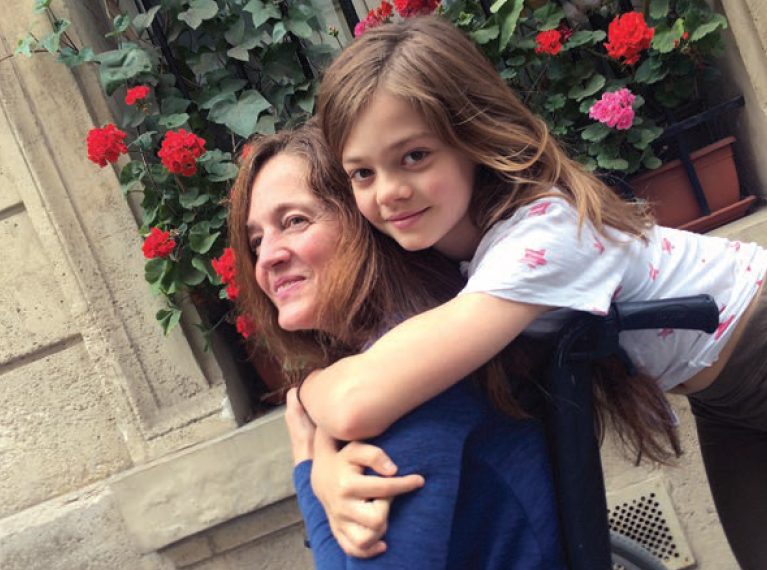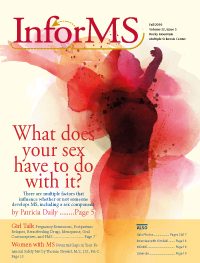Deciding when to start or grow a family is a complicated decision, made even more complicated when a diagnosis of MS is part of the picture. As with all aspects of MS, there isn’t one simple answer.
It’s important to know exactly what you’re getting into, even though outcomes and future prognosis are anyone’s guess. In this issue we’ve tried to lay out some general facts, but personal experiences will always differ.
Kim Ball joined the RMMSC Gala in September as our keynote speaker, where she shared her MS experience with help from a video featuring her young daughter Sienna. Kim is a native of the Denver area, and currently lives in Paris with her husband Tom and Sienna. We recently talked to Kim and asked her to share more of her personal story.
When were you first diagnosed with MS and how did the diagnosis transpire?
I was diagnosed twenty-one years ago, at the age of 28. I felt tingles in my toes — I ignored it, thinking my heels were too high. Then I felt tingles in my fingers a few weeks later. I mentioned it to my husband, Tom, and we laughed, calling it “clamaglobia” (our made-up name). The clamaglobia would come and go… so, no big deal.
A few months later, we were golfing. I was having difficulties seeing my ball in the middle of the fairway. Later that evening, we were looking for a movie in the newspaper and the ink looked splotchy. It was completely unreadable. Forgetting the previous symptoms of the tingles over the past months, I went to the eye doctor—of course! Instead of being told I had vision problems, I was told, “Well, your eyesight is 20/20, but the nerve in your right eye is not reacting to stimulus as it should.”
The doctor then asked me if I noticed my vision became blurry after a hot shower or after playing a sport that increased my body temperature. He even asked me if I’d felt tingles in my appendages. Lastly, he asked me if I had heard of multiple sclerosis. “No,” I hadn’t heard of MS.
After a series of external nerve tests and a MRI of my brain, I was told, “Good news. You don’t seem to have MS,” but we all agreed that something wasn’t right. Tom got on the phone with the MS Society, who told him to get my spinal fluid checked and a MRI of the spine. So, there you go. They found lots of lesions and mercury in my spinal fluid. I was diagnosed with relapsing-remitting MS.
How did you and your husband come to the decision to have a child?
The first question we asked when I was diagnosed was, “Is MS hereditary?” If the answer had been “yes,” then we would have adopted. We both wanted to be parents — that was never a question.
What was your experience like as you were pregnant and living with MS?
When I got pregnant with Sienna, I was 38. MS symptoms went away and I had more energy while pregnant than before.
About a year and half ago, you began using a wheelchair – how has that impacted your relationship with your daughter?
I was walking with a cane but barely walking. I had also lost the use of my left hand — so basically, MS had reduced mobility of my left side. It was awful not being able to participate physically in Sienna’s active toddler life. As Sienna grew up, I was fed up with not being able to stroll Paris with her, walk to lunch, go to school with her, and shop together. So, I asked my neurologist how I’d go about getting an electric wheel chair. I wanted wheels that could keep up with me, to help me do what and go where I wanted to. Walking at a snail’s pace — actually, I’m insulting snails, as they moved quicker than I did — and feeling exhausted every few feet was insane. My doctor cautioned me, saying I needed to keep walking. But knowing that my walking longer or any faster was not going to improve, I insisted on the chair. I had a life to live. And now, with my set of wheels, I go! Everywhere. And I smile. I’m happy. I’m out and about. Thank God.
As for my daughter, she loves it too. I’ve even been fortunate to assist her school class on a recent field trip where volunteers were needed to help keep the kids wrangled together as they walked the streets of Paris. I know I was the happiest volunteer there. Walking, in my case, is overrated. I love my chair and I work with a physical therapist four days a week to keep myself strong.
Do you have any advice for other couples considering the same thing?
Tom and I made sure we had full-time nanny support to diminish any misuse of my mental energy that I desperately wanted to save for Sienna. Being a mother is tiring. MS is exhausting. Put the two together, and that means you need help from someone.
I also chose to have faith in Sienna’s ability to do things on her own at a very early age. I’m the one with MS, not her. So, if MS prevented me from participating in an activity that she wanted to do, I’d give her the common sense talk and then I’d say “Go!”
Is there anything else you’d like to share?
Sienna is my ray of sunshine. She gives me more happiness and energy than MS takes away from me. I was told by my doctor (who is wonderful) that often we see a set-back or a relapse in MS after child birth, meaning that I may decline quicker than I would otherwise. For me, not having the love of a child that both my husband and I wanted just because MS may decline more quickly was never a consideration for either of us. In fact, I live with secondary progressive MS now at age 49. I can’t express how much purpose and fulfillment Sienna brings to my life. In other words, I can’t imagine living with MS and not having Sienna. She is everything to me.
Click here to view a video presented at the 2016 MS Center Gala featuring Kim and Sienna.






